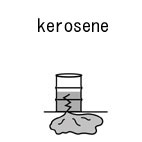| Case Name |
Spouting out of kerosene from a joint part of the vent valve of a kerosene feed pump at a gas turbine power generator |
| Pictograph |

|
| Date |
February 22, 1988 |
| Place |
Kawasaki, Kanagawa, Japan |
| Location |
Power station |
| Overview |
The air vent piping of the pump sending fuel to the gas turbine for power generation was damaged, and 4000 liters of kerosene spouted out. A total of 500 liters kerosene flowed into the canal via the sewer. The points that might cause leakage were predicted, preventing the oil from spreading out of the factory. A leakage oil detector was also installed in the gas turbine. |
| Incident |
Air vent piping of a pump that sent fuel to the gas turbine for power generation was damaged. 4000 liters of kerosene spouted out. 500 liters of kerosene flowed out into the canal via a sewer. Refer to Fig2. |
| Processing |
Consumption and usage |
| Substance |
Kerosene |
| Type of Accident |
Leakage, environmental pollution |
| Sequence |
1. The power station was completed in January, 1981.
2. Turnaround shutdown maintenance was carried out in September and October, 1987, and operation was restarted on November 1st.
3. The plant was operated from 5:00 to 24:00 every day.
4. On February 22nd, 1988, the kerosene feed rate suddenly increased under usual operation.
5. Kerosene spouted from the connection of an air vent valve of the main piping of the kerosene feed pump.
6. The screw section for a joint of the vent pipe was damaged.
7. The amount of leakage was 4000 liters, of which 3500 liters stayed at the lower side of the generator, and 500 liters flowed out into the canal. |
| Cause |
The screw section of air vent piping was broken by fatigue failure due to repeated stress from vibration. Sufficient countermeasures had not been taken to prevent vibration stress, although the mounting spot was close to the kerosene feed pump and there was vibration from revolutions of the pump. |
| Response |
An emergency shutdown of the generator. An oil fence was installed to stop the flow and oil treatment agent was applied. |
| Countermeasures |
The position of the air vent piping was changed. An oil detector was installed in the gas turbine to prevent direct leakage of oil via the sewer. Thorough inspections were carried out on other points. |
| Knowledge Comment |
Equipment construction is required to prevent hazardous materials from flowing outside. Small vibrations may cause fatigue if they are repeated for a long time. |
| Background |
1. A screwed connection was adopted although it is not considered suitable for kerosene piping of 3.0 MPa pressure. Screwed connection is not recommended because there are some defects such as the screw part becomes thinner, or it tends to leak compared to welding.
2. Piping of 14 mm nominal diameter was adopted. As the size of a pipe becomes smaller, the strength of piping decreases. A 14 mm diameter pipe may be selected for the vent hole of pump, but it should not be selected in a petroleum refinery or a petrochemical plant.
3. Prior assessment of the load on the piping was insufficient. However, prior assessment is not usually performed of this kind of vent piping. It might be a problem of a design standard. |
| Incidental Discussion |
Many Japanese oil refineries use valves of 20 mm in nominal diameter for drain and vent piping as a large number of valves are required and the flow rate ti be processed is not high. Some overseas major petroleum refining and petrochemical plants choose 50 mm considering strength. |
| Reason for Adding to DB |
Example of leakage caused due to a mistake in selection of a small part and incorrect handling |
| Scenario |
| Primary Scenario
|
Insufficient Analysis or Research, Insufficient Practice, Effect of Vibration by Rotating Machine, Organizational Problems, Poor Staff, Poor Experiment of Staff, Poor Value Perception, Poor Safety Awareness, Inadequate Risk Recognition, Planning and Design, Poor Planning, Poor Design, Usage, Operation/Use, Operation of Rotating Machine, Bad Event, Mechanical Event, Vibration, Failure, Fracture/Damage, Fatigue Failure, Secondary Damage, Damage to Environment, Flowout to Sea
|
|
| Sources |
Kawasaki City Dangerous objects safety research association. Examples of accident at dangerous facilities. Accident case that is currently useful with FTA. pp.53-55(1997).
Kawasaki City Fire fighting station. Prevention division, Peace section. N railway Co., Ltd. Outline of blowout of dangerous materials at K power plant ( No.1 and 2 power generator). Material of the Kawasaki City Complex safety countermeasure committee.
|
| Physical Damage |
Breakage of air vent piping. About 4000 liters of kerosene spouted out. |
| Financial Cost |
¥ 90,000 (Material of the Kawasaki City Complex safety countermeasure committee |
| Consequences |
500 liters of kerosene leaked into the Tanabe canal. An oil fence was extended to stop the flow, and detergent was applied |
| Multimedia Files |
Fig2.Sketch around fuel pump
|
| Field |
Chemicals and Plants
|
| Author |
WAKAKURA, Masahide (Kanagawa Industrial Technology Research Institute)
TAMURA, Masamitsu (Center for Risk Management and Safety Sciences, Yokohama National University)
|